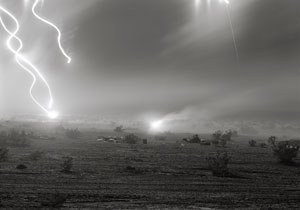3.15.24 — A War with Many Sides
An-My Lê could be a citizen of the world if she did not have so many memories. Her retrospective opens with a photograph of a schoolgirl. Could it be her?
I doubt it, but with Lê you never know. What looks later like ground action in the Vietnam War is only a recreation in North Carolina or Virginia—or a training exercise in California for wars closer to today. Wall text speaks only of her return to Vietnam in 1994, nineteen years after the fall of Saigon, and what she set out to see. Still, she is not saying, and she herself had barely entered her teens when she left for America. But then she is never saying, in photos that speak for all sides, apart perhaps from her own.  She is forever “Between Two Rivers,” at MoMA through March 16—and I work this together with recent reports on photography from Lagos and from Tracey Rose in South Africa as a longer review and my latest upload.
She is forever “Between Two Rivers,” at MoMA through March 16—and I work this together with recent reports on photography from Lagos and from Tracey Rose in South Africa as a longer review and my latest upload.
That serious schoolgirl says little as well. She takes care with everything, right down to a proper hat, and her glance gives nothing away. Nor does that first series in Vietnam. Boys playing soccer dissolve in a blur, while adults mill about. A tiger cage and a vast interior with a single desk are devoid of life. Yet Lê is determined to see it all and to listen.
She is caught up in it all as well. That first series took her to the former South Vietnam, where she had lived, and to the north, which held childhood memories as well, but of her mother’s childhood. It also includes shots of Louisiana, where she had fled. The Vietnam War reenactment did not just allow her to participate, but demanded it in exchange for letting her observe. Naturally she fought on both sides. And could that be her playing pool with sailors?
Lê gives the show’s title in English, Vietnamese, and French, not just because Vietnam was once a French colony, but also because she spent much of her childhood in Paris. The two rivers are primarily the Mekong and the Mississippi, but also the Seine, the Rio Grande were she traveled to observe the border, and the Hudson, where she taught upriver from New York City. She also finds affinities. The Mekong and the Mississippi both have storied deltas and storied poverty, and the bayou has a parallel in Vietnam;s tall grass, swampy pools, and flat, parched land. It, too, might make a miserable place for a war. It also helps drive a lifelong conviction that landscape means as much as people.
How much do they mean? They are still not letting on. One might never know one side from the other in the reenactments without a photo’s title. Maybe that is what was so wrong with the war. For ever so many, as another title has it, it was Someone Else’s War at that. Events Ashore shows the U.S. Navy engaged in scientific research, earthquake relief, and flood prevention, but Lê knows that all these, a navy included, may descend on countries like a show of force.
Her latest series, a shift to color, takes her across the United States, looking for clues to its controversies and turmoil, and she herself may wonder whether she finds them. Students protest against guns, but half the time in the background. Migrant labor blends easily into a cattle drive, and the White House briefing room is breaking down or still setting up. Here Confederate statues are neither going up nor coming down. Her very artlessness can seem an evasion. The closest her reenactors come to war’s drama and fear is lightning descending on night ops.
The curators, Roxana Marcoci with Caitlin Ryan, take one series at a time. Think of them less as finished work than as personal projects, to which Lê can devote herself completely. She does arrange one series in an open circle, like an old-fashioned diorama. Its fourteen landscapes cover a lot of ground. Does that add up to common ground or telling contrasts? Once again, she is not saying.
Lê’s photos can seem all but artless, and well-meaning critics may praise her more for her history than for her art. The Navy removes unexploded ordinance, but with none of the poignancy of Tuan Andrew Nguyen, for whom Vietnam’s past is a minefield, or of boat people for Danh Vo. That diorama might be more immersive if its components meant more. Still, silence speaks to her own sense of helplessness or displacement. When she returned to her last childhood home, “I felt that I didn’t recognize anything,” but she kept looking. For her, a refusal to take sides is taking sides, but in a different war than either side ever knew.
Read more, now in a feature-length article on this site.